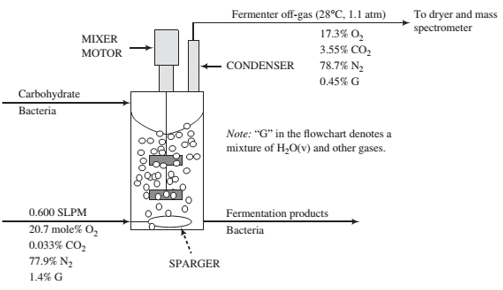
Fermentation is a biochemical process in which a carbohydrate—such as the sugar glucose—is converted by bacteria or yeast to an organic compound—such as ethanol—and carbon dioxide. The process is best known for its use in making beer_ wine, and other alcoholic beverages, but it is also used to produce a wide range of other industrially important chemicals.
The diagram below shows a continuous fermentation process. An aqueous solid-liquid slurry containing a carbohydrate and bacteria enters a stirred tank where it undergoes fermentation. Fermentation products, including species condensed from the off-gas, and bacteria are withdrawn from the tank. A mixer with multiple rotating impellers keeps the solids in the tank suspended in the liquid. An air stream enters the fermenter through a sparger (something like an inverted shower head) designed to produce small bubbles that rise through the mixture and remove the CO2 formed in the reaction. Some of the oxygen in the air fed to the fermenter is consumed by the bacteria. The gas products go through a condenser, which condenses most of the water and returns it to the fermenter, and the uncondensed off-gas goes to a dryer and then to a mass spectrometer, where its composition is determined. The ?ow rate of the air feed is measured to be 0.600 SLPM (liters per minute at standard temperature and pressure) and the measured compositions of the air and the off- gas are shown on the diagram. The off-gas is at 28°C and 1.1 atm.

(a) Describe in your own words the purpose of this process and the functions of the mixer, the air, and the sparger.
(b) In a small laboratory fermenter, the mass of the broth in the tank is 0.58 kg, and the broth density is 1.05 kg/L. Calculate the carbon dioxide evolution rate (CER) and the oxygen uptake rate (OUR) in mmol/(h ( L), where the volume unit in the denominator refers to the volume of broth in the tank. Also, calculate the off-gas volumetric ?ow rate in L/min.
Want to see the full answer?
Check out a sample textbook solution
Chapter 5 Solutions
ELEMENTARY PRINCIPLES OF CHEM. PROCESS.
Additional Science Textbook Solutions
Starting Out with Java: From Control Structures through Data Structures (4th Edition) (What's New in Computer Science)
Degarmo's Materials And Processes In Manufacturing
Starting Out with C++: Early Objects (9th Edition)
Computer Science: An Overview (13th Edition) (What's New in Computer Science)
Database Concepts (8th Edition)
Java How to Program, Early Objects (11th Edition) (Deitel: How to Program)
 ChemistryChemistryISBN:9781305957404Author:Steven S. Zumdahl, Susan A. Zumdahl, Donald J. DeCostePublisher:Cengage Learning
ChemistryChemistryISBN:9781305957404Author:Steven S. Zumdahl, Susan A. Zumdahl, Donald J. DeCostePublisher:Cengage Learning ChemistryChemistryISBN:9781259911156Author:Raymond Chang Dr., Jason Overby ProfessorPublisher:McGraw-Hill Education
ChemistryChemistryISBN:9781259911156Author:Raymond Chang Dr., Jason Overby ProfessorPublisher:McGraw-Hill Education Principles of Instrumental AnalysisChemistryISBN:9781305577213Author:Douglas A. Skoog, F. James Holler, Stanley R. CrouchPublisher:Cengage Learning
Principles of Instrumental AnalysisChemistryISBN:9781305577213Author:Douglas A. Skoog, F. James Holler, Stanley R. CrouchPublisher:Cengage Learning Organic ChemistryChemistryISBN:9780078021558Author:Janice Gorzynski Smith Dr.Publisher:McGraw-Hill Education
Organic ChemistryChemistryISBN:9780078021558Author:Janice Gorzynski Smith Dr.Publisher:McGraw-Hill Education Chemistry: Principles and ReactionsChemistryISBN:9781305079373Author:William L. Masterton, Cecile N. HurleyPublisher:Cengage Learning
Chemistry: Principles and ReactionsChemistryISBN:9781305079373Author:William L. Masterton, Cecile N. HurleyPublisher:Cengage Learning Elementary Principles of Chemical Processes, Bind...ChemistryISBN:9781118431221Author:Richard M. Felder, Ronald W. Rousseau, Lisa G. BullardPublisher:WILEY
Elementary Principles of Chemical Processes, Bind...ChemistryISBN:9781118431221Author:Richard M. Felder, Ronald W. Rousseau, Lisa G. BullardPublisher:WILEY





